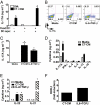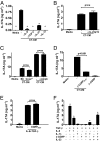Mucosal adjuvant activity of cholera toxin requires Th17 cells and protects against inhalation anthrax
- PMID: 20479237
- PMCID: PMC2890829
- DOI: 10.1073/pnas.1002348107
Mucosal adjuvant activity of cholera toxin requires Th17 cells and protects against inhalation anthrax
Abstract
Cholera toxin (CT) elicits a mucosal immune response in mice when used as a vaccine adjuvant. The mechanisms by which CT exerts its adjuvant effects are incompletely understood. We show that protection against inhalation anthrax by an irradiated spore vaccine depends on CT-mediated induction of IL-17-producing CD4 Th17 cells. Furthermore, IL-17 is involved in the induction of serum and mucosal antibody responses by CT. Th17 cells induced by CT have a unique cytokine profile compared with those induced by IL-6 and TGF-beta, and their induction by CT requires cAMP-dependent secretion of IL-1beta and beta-calcitonin gene-related peptide by dendritic cells. These findings demonstrate that Th17 cells mediate mucosal adjuvant effects of CT and identify previously unexplored pathways involved in Th17 induction that could be targeted for development of unique mucosal adjuvants.
Conflict of interest statement
The authors declare no conflict of interest.
Figures






Similar articles
-
Effective mucosal immunity to anthrax: neutralizing antibodies and Th cell responses following nasal immunization with protective antigen.J Immunol. 2003 Jun 1;170(11):5636-43. doi: 10.4049/jimmunol.170.11.5636. J Immunol. 2003. PMID: 12759444
-
Intranasal delivery of cholera toxin induces th17-dominated T-cell response to bystander antigens.PLoS One. 2009;4(4):e5190. doi: 10.1371/journal.pone.0005190. Epub 2009 Apr 10. PLoS One. 2009. PMID: 19360100 Free PMC article.
-
Helper T cell subsets for immunoglobulin A responses: oral immunization with tetanus toxoid and cholera toxin as adjuvant selectively induces Th2 cells in mucosa associated tissues.J Exp Med. 1993 Oct 1;178(4):1309-20. doi: 10.1084/jem.178.4.1309. J Exp Med. 1993. PMID: 8376936 Free PMC article.
-
Effects of cholera toxin on innate and adaptive immunity and its application as an immunomodulatory agent.J Leukoc Biol. 2004 May;75(5):756-63. doi: 10.1189/jlb.1103534. Epub 2004 Jan 2. J Leukoc Biol. 2004. PMID: 14704372 Review.
-
Strategies for the induction of immune responses at mucosal surfaces making use of cholera toxin B subunit as immunogen, carrier, and adjuvant.Am J Trop Med Hyg. 1994;50(5 Suppl):42-54. Am J Trop Med Hyg. 1994. PMID: 8203723 Review.
Cited by
-
The catalytic A1 domains of cholera toxin and heat-labile enterotoxin are potent DNA adjuvants that evoke mixed Th1/Th17 cellular immune responses.Hum Vaccin Immunother. 2015;11(9):2228-40. doi: 10.1080/21645515.2015.1026498. Hum Vaccin Immunother. 2015. PMID: 26042527 Free PMC article.
-
Nod2-mediated recognition of the microbiota is critical for mucosal adjuvant activity of cholera toxin.Nat Med. 2016 May;22(5):524-30. doi: 10.1038/nm.4075. Epub 2016 Apr 11. Nat Med. 2016. PMID: 27064448 Free PMC article.
-
The cAMP Pathway as Therapeutic Target in Autoimmune and Inflammatory Diseases.Front Immunol. 2016 Mar 31;7:123. doi: 10.3389/fimmu.2016.00123. eCollection 2016. Front Immunol. 2016. PMID: 27065076 Free PMC article. Review.
-
Inhibition of Gαs/cAMP Signaling Decreases TCR-Stimulated IL-2 transcription in CD4(+) T Helper Cells.J Mol Signal. 2015 Jul 6;10:2. doi: 10.5334/1750-2187-10-2. J Mol Signal. 2015. PMID: 27096000 Free PMC article.
-
Mucosal Adjuvants Delivered by a Mucoadhesive Patch for Sublingual Administration of Subunit Vaccines.Int J Mol Sci. 2022 Nov 3;23(21):13440. doi: 10.3390/ijms232113440. Int J Mol Sci. 2022. PMID: 36362224 Free PMC article.
References
-
- Northrup RS, Fauci AS. Adjuvant effect of cholera enterotoxin on the immune response of the mouse to sheep red blood cells. J Infect Dis. 1972;125:672–673. - PubMed
-
- Elson CO, Ealding W. Generalized systemic and mucosal immunity in mice after mucosal stimulation with cholera toxin. J Immunol. 1984;132:2736–2741. - PubMed
-
- Freytag LC, Clements JD. Mucosal adjuvants. Vaccine. 2005;23:1804–1813. - PubMed
-
- Vanden Broeck D, Horvath C, De Wolf MJ. Vibrio cholerae: Cholera toxin. Int J Biochem Cell Biol. 2007;39:1771–1775. - PubMed
Publication types
MeSH terms
Substances
Grants and funding
LinkOut - more resources
Full Text Sources
Other Literature Sources
Medical
Molecular Biology Databases
Research Materials

